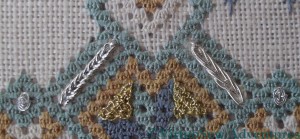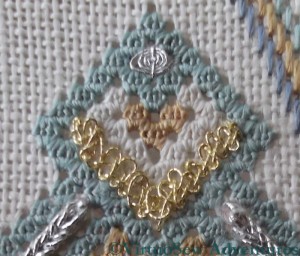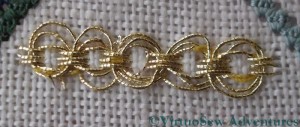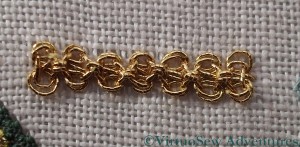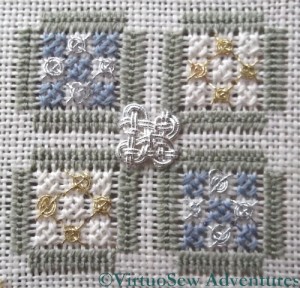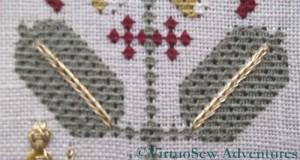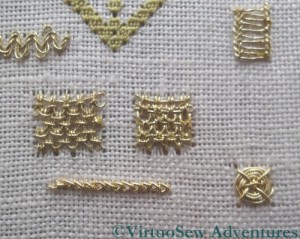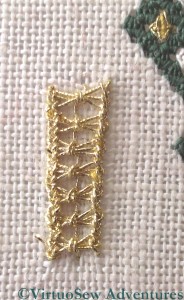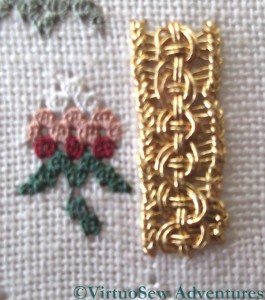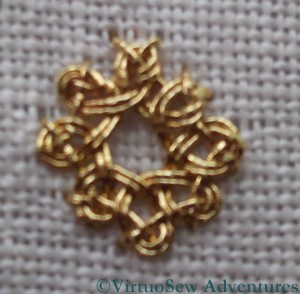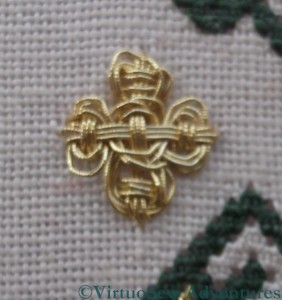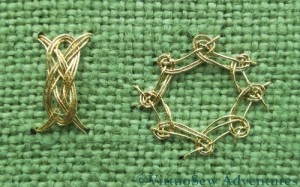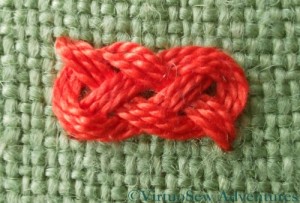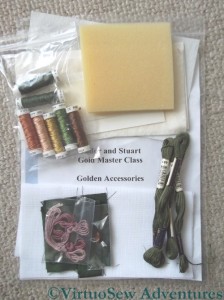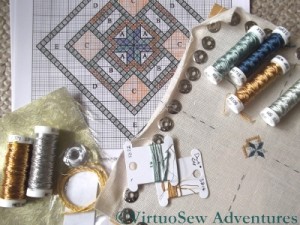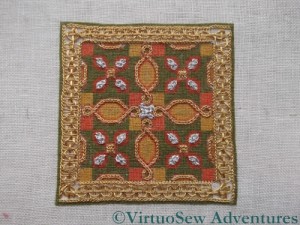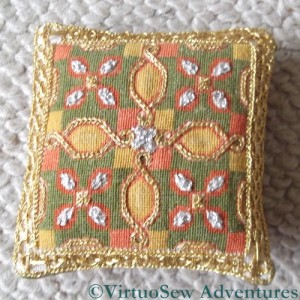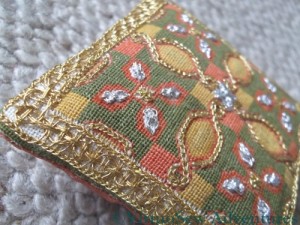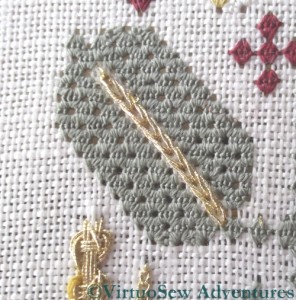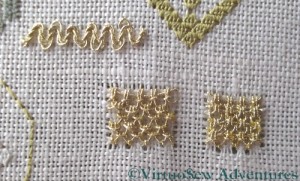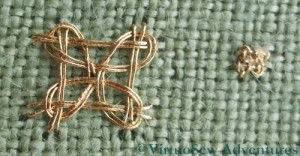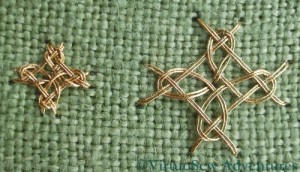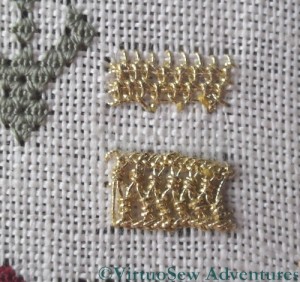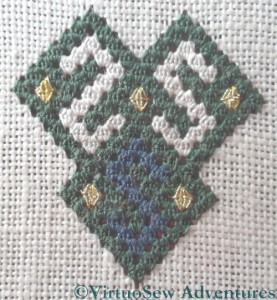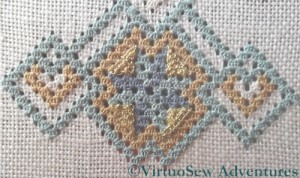Category: Tudor and Stuart Gold Master Class
More variations of Goldwork on the Spot Sampler
There are two more versions of heavy chain stitch here, again using different threads. This time the threads are so different that I snipped out the larger one, on the right, and reinstated it using the finer thread. This photo also shows the detached buttonhole filling with return, worked in the finest of the gold threads. This was rather a challenge as well. I believe it will appear again in the Petite Pincushion, so I will soon get to practise it once more.
In ordinary pearl cotton, braid stitch is one of my favourites, but in metal thread it is much more of a challenge, especially at a diagonal, and on a fabric which is coarse enough to be much better used in a counted fashion! As you can see in this photo, it creates a lovely rich looped effect – rather like a braid you might use in furniture or to trim a coat, but it doesn’t really bear close inspection, because some of the loops more closely resemble knots!
The tiny four legged spiders web stitch seemed to come together much more easily than the first set I did, so I am clearly getting a better grip on it!
This Guilloche Variation is actually the stitch that most of my stitch dictionaries refer to as “guilloche stitch”, although they generally only have one run of interlacing rather than three. For some reason the thread broke up quite a bit, and I had my customary trouble with the interlacing loops. I wonder whether the relative simplicity of the stitch makes me rush more when I’m doing it?
Figure Eight Interlacing stitch is great fun. I had a little trouble getting the first set of loops to lie flat as they are supposed to, but after that, the stitch just fell into place. This would be another good one for using to represent intricate gold jewellery or ornamentation on my Dreams of Amarna panels.
More spots on the Spot Sampler
Even the macro setting on my camera has trouble with some of the fine detail here. The fine gold and silver threads used for the four-legged spider’s web stitches is barely heavier than the silk thread, and was quite a challenge to stitch with. At true size they create the smallest of subtle glimmers, rather than any dramatic effect.
The square interlacing stitch, on the other hand, makes its presence felt in no uncertain terms! It was fun to do, although using the heavy silver thread I did wonder whether the interlacing was going to create rather a congested appearance. I don’t think it does, but if there is one thing I have learnt from this course, it is “Test, Test, Test”. It is all very well being confident of how to work the stitch, but with the huge range of metal threads available and the variants of scale and flexibility, it’s much harder to be confident of the final effect if you don’t test it on the right fabric at the right scale!
The two rows of heavy chain stitch here are worked with different threads. The difference is subtle, and harder to see on the photo than in real life, because even the fact that the row of stitches are at different angles contributes to the effect. I’ve found heavy chain stitch a remarkably difficult stitch to work using metallic threads, and I’m not sure quite why, because I don’t find it at all difficult using cotton or silk!. I am assuming that it is a matter of tension, but since my various efforts haven’t cracked it yet, all I can say is “Needs More Work!”
Here you see a whole range of spots, worked with varying degrees of success.
I’ve had plenty more practice with Ladder Stitch since I worked this set, but I still find that one side of the stitch ends up appearing “turned over” compared with the other, which lies flat. Another stitch that needs more work…
I like the dense fabric produced by the two variants on Up-And-Down Buttonhole Filling, although strangely they don’t look as different from one another in the photo as they do in real life.
Eight-legged spider’s web stitch is more stable than the four-legged version – there are more stitches to keep it under control – and it produces a good, flat boss. It would probably be a good choice in places where the square interlacing stitch would draw too much attention to itself!
Still more on the Spot Sampler
We’ve had a sudden spurt of good weather and good light recently, so I’ve been making hay while the sun shone (literally!). I’ve also been making an effort to use all of the different gold threads that Tricia provided in the kit, some of them real metal threads, some of them imitation, some thick and some thin.
The Wheatsheaf on Ladder Stitch and the Guilloche on Ladder Stitch are in different shades of gold and even different types of thread. There is even a Queen Stitch in a very fine gold thread in the top corner of the picture showing the Wheatsheaf on Ladder Stitch. The one I used for the Guilloche variation is the one I used for most of the practice cloth. It’s surprisingly floppy for a metal thread, which helps with some of the stitches, but not all. In this particular case, at least there were no breaks in the metal, unlike in the Wheatsheaf stitch!
The Eight Sided Interlacing Stitch was an absolute treat to do. It’s important to count the foundation correctly, but from then it was simply a matter of repeating the same set of actions. I’m rather pleased that, by and large, the threads have stayed neatly side-by-side!
The Cross Variation Guilloche Stitch makes a great contrast with Eight Sided Interlacing – not only yet another different thread, this one a little stiffer, and a slightly different shade of gold, but also an upright, angular form, rather than the almost circular appearance of Eight Sided Interlacing.
Tudor and Stuart Masterclass – Month Seventeen
Month Seventeen’s stitches were Eight Sided Interlacing Stitch, and the Josephina Knot. I rather enjoyed them, too – they’re both very ornamental indeed!
The Eight Sided Stitch is less scary than you might expect on first sight, although I was slightly surprised to realise that the foundation layer interlaced in the direction contrary to the one I expected.
It will be more exciting at the smaller size on the real sampler, but I feel that I understand the structure, at least, and that is the important point, at this stage.
However, if you look at the gold Josephina Knot in the top picture, you will see that I didn’t quite get the hang of that one…
This pearl cotton version shows what I was aiming for. It’s a really lovely ornamental spot stitch, with a slightly Celtic feel to it. However, if the interlacing goes wrong at any point during the working, it is very hard to recover – and not always easy to see before you’ve finished, either.
I made extensive use, for these stitches, of a belated birthday present from Elmsley Rose – a set of bone needlework awls/stilettos. I have a steel laying tool, but it’s so sharp that it’s not a good tool for coaxing threads into place. My birthday presents were just perfect – Thank You, Megan!
Tudor and Stuart Goldwork Masterclass – Bonus Instructions
There was a set of Bonus Instructions in the instructions for Month Fifteen, from a teaching project that Tricia had retired from use. She was asked whether she’d produce kits of the materials for those of us who don’t have easy (or even difficult!) access to a really good needlework shop. Yet again, apparently, demand outstripped her expectations (a good problem to have!), and here is my kit.
It includes finishing materials for the various accessories, as well as the fabric and the silk thread, but not the metal thread, since all of us already have large spools of that from doing the main Spot Sampler.
My intention is to finish these to add to that planned “winter decoration corner” I’ve mentioned a couple of times. I’ve found some masks which I’m going to decorate in silver and gold, and I will use some metallic gauze or something similar for the background. Already the two Needlework Nibbles, the Floral Glove Needlecase and the Tudor Pincushion look like they will create some wonderful reflective textures for a dark corner…
Tudor and Stuart Masterclass – Beginning the Petite Pincushion
There were two additional projects included in the Tudor and Stuart Goldwork Masterclass, to provide further opportunities to use some of the stitches we are learning. The Tudor Pincushion was one, and this “Petite Pincushion” is the second. The materials include a piece of silk brocade for the backing, some gold cord to provide an ornamental edge, and more spools of assorted metal threads for the goldwork stitches.
Whereas the silk stitchery for the Tudor Pincushion was in primarily in Tent Stitch, most of the silk work on the Petite Pincushion is in Queen Stitches. I’ve not done any since I finished the silkwork on the sampler, and I am finding that I am having to remind myself to pull them tight to create the openwork effect. I will have to remember to line the embroidered side of the pincushion or the stuffing will poke out through the gaps!
I stitched centre lines on the fabric, but as you can see, once I had the first stitch placed I snipped out the middle stitches and pulled them back out of the way.
I’ve already finished with two of the silk colours, which appear only in the central starburst. Now I just have to do rows of strapwork in the other two colours, as well as the four blocks of tent stitches that provide a basis for a rather intriguing-looking interwoven stitch which will probably be nearly the last element I add.
Tudor Pincushion Finished
The final stitch in the Tudor Pincushion was the central boss in Four Sided Interlacing Stitch, which slotted nicely into place after I received the instructions for Month 16.
I decided – after staring at it intermittently while I’ve waited for the stitch to turn up – that I was happy enough with the border and did not need to unpick it. So the next phase was to attach the silk backing and stuff the pincushion.
I’ve tried not to over-stuff it, since I intend to use it as a decoration and not as a pincushion, but I still found myself pushing more stuffing in than I expected. Unlike the Tulip Slip Pincushion, where the velvet was so tough that I used a sewing machine, this one is finished entirely by hand, and stuffed enough to look plump and fat, but not so much that the fabric is strained.
I’m finding with Tricia’s various pieces that photographing them from an angle sometimes produces a much clearer view of the stitching. There is certainly less likelihood of “glare” from the metal threads. Besides, after all that effort, I’m more than happy to show off a little…!
Tudor and Stuart Goldwork Masterclass – Spot Sampler Progress
I’m only adding a few stitches at a time to the Spot Sampler, partly because I want to take my time, and partly because I’m rather keen on the Christus Natus Est panel at the moment and seem to spend most of my daylight stitching time on that.
I was a little disappointed with this Heavy Chain Stitch when I worked it, because it seemed rather thin and attenuated. I tried using my laying tool to keep the loops open and reduce the abrasion of the yarn, but since the laying tool is a sharply-pointed piece of metal, it presented its own hazards. I might work the other leaf of this pair in the other thread to see whether it creates a different effect.
The two stitches shown here are the Up and Down Buttonhole Stitch variations. In the alternating variation, I realise now I look at the close up, I forgot to include the “return” or straight stitch across at each level. Yet another stitch to re-do in the margins!
The bar at the top is Diagonal Half Guilloche Stitch, and it looks much tidier at the proper size, rather than in close-up!
Tudor and Stuart Goldwork Masterclass – Month Sixteen
The stitches for Month Sixteen are stitches that create prominent large “spots” of intricate pattern. They are simple enough in concept – there is a foundation of straight stitches, and an interlaced pattern worked around the foundation. Naturally, the actual working of the stitch proves to be less than entirely straightforward. I try to vary the scale of the stitches I work on my practice cloth, but in the case of Four Sided Interlacing Stitch when I was trying to work it as a counted stitch, the only variations I could create successfully were “Huge” and “Tiny”. At the smaller scale shown there is really little point in using an interlacing stitch like this, and one might more sensibly choose something a little simpler to work. At the large size, the effect of the metal thread is diluted by the background fabric.
In the case of Diagonal Four Sided Interlacing Stitch my two different scales worked slightly better.
I know, by the way, that in the case of one of these stitches, I made a mistake in the foundation layer which lead to a further mistake in the interlacing. I can’t find it now, and I’m going to be intrigued to see how often I get these stitches right, when I start working them on the sampler itself!
Tudor and Stuart Goldwork Masterclass – more gold added
I’ve been persevering with adding the goldwork stitches to the Spot Sampler. Tricia set up a Yahoo Group for the course so that we could help each other out, and I posted some of my headaches to that.
I received a good many helpful suggestions, and on top of that, Tricia posted a very long response on the Question and Answer blog, which included the reassuring detail that when she’s reverse-engineering the stitches, she uses the point at which the thread sheds to help her determine whether she is really doing the stitch that she’s trying to. Some shredding is to be expected, then…
I think I’m doing better now, as I am finding there is rather less shredding (although there is still some). I suspect my tension is sometimes too tight, and Tricia has suggest that my Ladder Stitch in particular could do with being loosened up a little. Having the tension too tight will abrade the thread further as I make each stitch.
The detached buttonhole with return that forms the first embellishment on the large pattern at the bottom of the sampler was rather a surprise. It’s more raised than the photo of Tricia’s finished piece suggests, and I got into a tangle working it, although that is because the position of the stitches on the frame were not as comfortable to work from some angles as others. I find myself wondering how RSN needlewomen manage with those large slate frames!

